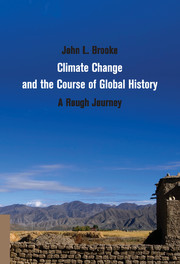Book contents
- Frontmatter
- Dedication
- Contents
- List of Figures and Tables
- Acknowledgments
- List of Abbreviations
- Introduction
- Part I Evolution and Earth Systems
- Part II Domestication, Agriculture, and the Rise of the State
- Part III Ancient and Medieval Agrarian Societies
- Part IV Into the Modern Condition
- 10 Climate, Demography, Economy, and Polity in the Late Medieval–Early Modern World, 1350–1700
- 11 Global Transformations: Atlantic Origins, 1700–1870
- 12 Launching Modern Growth: 1870 to 1945
- 13 Growth beyond Limits: 1945 to Present
- Coda
- Data Bibliography: Full Citations for Data Used in Figures and Tables
- Index
- References
10 - Climate, Demography, Economy, and Polity in the Late Medieval–Early Modern World, 1350–1700
Published online by Cambridge University Press: 05 August 2014
- Frontmatter
- Dedication
- Contents
- List of Figures and Tables
- Acknowledgments
- List of Abbreviations
- Introduction
- Part I Evolution and Earth Systems
- Part II Domestication, Agriculture, and the Rise of the State
- Part III Ancient and Medieval Agrarian Societies
- Part IV Into the Modern Condition
- 10 Climate, Demography, Economy, and Polity in the Late Medieval–Early Modern World, 1350–1700
- 11 Global Transformations: Atlantic Origins, 1700–1870
- 12 Launching Modern Growth: 1870 to 1945
- 13 Growth beyond Limits: 1945 to Present
- Coda
- Data Bibliography: Full Citations for Data Used in Figures and Tables
- Index
- References
Summary
The epoch between the Black Death and the onset of the Industrial Revolution was the fundamental hinge of human history. During the three and a half centuries between 1350 and 1700, the path of the human condition was shaped by a final florescence of the patterns that had consolidated after the last Hallstatt solar crisis and the Old World Iron Age and by a profound deflection toward the explosive expansions, capacities, and perils of our modern condition.
Perhaps because of this epoch’s fundamentally contradictory, transitional nature, again we have a problem with labels and definitions. Traditionally, in chronologies defined by European history, this era consists of the Late Middle Ages, from 1350 to 1500, and the early modern period, from 1500 to 1815. Obviously, no one at the time would have recognized their respective “lateness” or “earliness,” though they might well have sensed enduring continuity and new departures. But in hindsight we can see broad parallel shifts in societies around the globe, in a wave front of advance that looks more like that of the ancient world than it does that of the Middle Ages. These three centuries saw not just a recovery from the Black Death in Eurasia and the medieval megadroughts in parts of the tropics, but a long surge of population growth, trade, Smithian economic growth, and the consolidation of the authority and reach of state governance. Perhaps the entire period from the recovery from the Black Death to the first launch of the steam engine could be called “late archaic,” or better yet, “late organic,” because from 1700 forward we can see the beginnings of the mineral energy economy.
- Type
- Chapter
- Information
- Climate Change and the Course of Global HistoryA Rough Journey, pp. 413 - 466Publisher: Cambridge University PressPrint publication year: 2014
References
- 1
- Cited by

